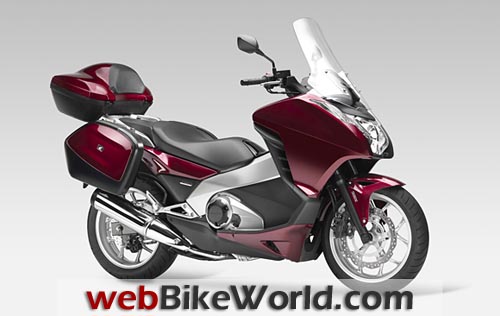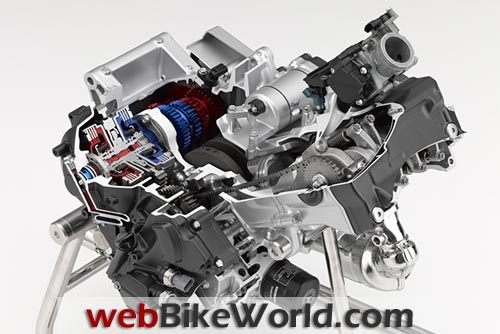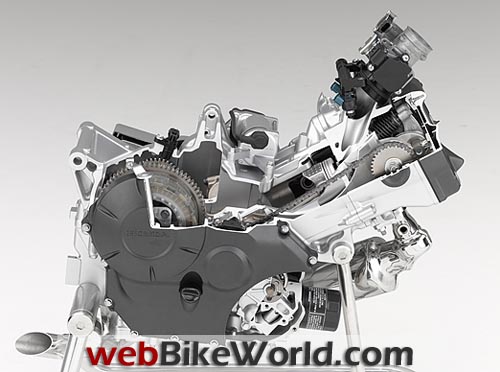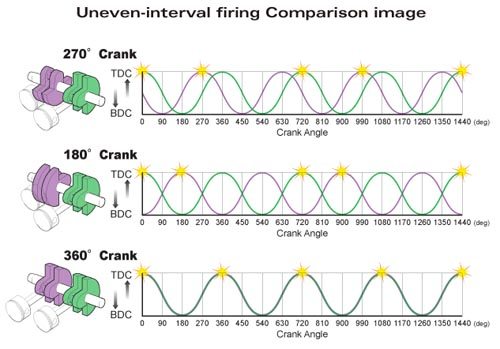Honda Announces “Global” 700 cc Twin Cylinder Motorcycle Engine and Lightweight, Compact 2nd Generation Dual Clutch Transmission
September 26, 2011 – Honda Motor Co., Ltd. made a highly detailed announcement today describing the development of a new motorcycle engine that will be fitted to European motorcycles.
The 700 cc twin engine is said to have “powerful torque in the low- to mid-speed range” and “range-topping fuel-efficient environmental performance”, along with a second-generation Dual Clutch Transmission.
The engine and the new Honda Integra will be unveiled at EICMA 2011 and webBikeWorld will be there to cover the event.
This new engine is a liquid-cooled, 700cc, 4-stroke, in-line, 2-cylinder engine that fits into the mid-class range (displacement between 500 and 750cc) popular in Europe.
Fuel economy exceeds 27 km/L (63 MPG), the best in the mid-class range, and achieves an approximate 40% improvement over other sports models in its class, according to Honda.
Honda said that the new engine can be coupled with a newly developed lightweight, compact second-generation Dual Clutch Transmission, featuring a “smooth, direct feel and excellent transmission efficiency, in addition to a 6-speed manual transmission”.
The new engine will be mounted in the new Honda Integra and other models based on different concepts, which will be on display at EICMA 2011 in Milan, Italy in November.

Honda 700 cc Global Twin Engine:
Honda developed this new motorcycle engine in order to realize a set of motorcycles based on its new concept of offering outstanding fuel efficiency in the mid-class while delivering powerful, throbbing torque in the normal range for touring and urban riding.
Development was performed to meet these requirements:
- An engine that is easy to handle with plentiful torque in the range normally used, and which also delivers a pleasant, throbbing feel during sporty rides.
- Top-class, fuel-efficient environmental performance best suited for the next-generation mid-class engine.
- A lightweight, compact design that allows more freedom in the body layout and provides highly convenient space.
Honda determined the engine layout after examining a variety of engine types from numerous perspectives and decided on an in-line, 700cc, 2-cylinder engine with a 62º forward lean (cylinder assembly angle).
To meet a wide variety of uses, two transmissions can be coupled with this engine: the second generation of Honda’s innovative Dual Clutch Transmission, and a 6-speed manual transmission.
 Engine Details
Engine Details
Higher combustion efficiency and lower friction
A wide variety of low friction technologies that aid better fuel economy are incorporated in the new engine. To improve fuel efficiency through better-controlled combustion while realizing a powerful ride in the low- to mid-rpm ranges, the bore/stroke ratio is set at 73×80mm.
An ideal combustion chamber shape and optimum valve timing also contribute to achieve stable combustion. Resin coating is applied to the pistons, and lightweight aluminum material is employed for the first time in a motorcycle in the friction-reducing roller rocker arm.
Uneven-interval firing and uniaxial primary balancer
Adoption of uneven-interval firing with a 270° phase crank and uniaxial primary balancer help realize an engine with a pleasant throbbing feel that also reduces vibration.
Branch intake port inside the cylinder head, valve timing
The layout of a branch intake port inside the cylinder head was chosen to have only one intake channel for two cylinders. This design creates deliberate interference between the two cylinders’ intake processes to achieve precisely calculated changes to combustion timing.
In addition, to change the valve timing between the two in-line cylinders with one camshaft, the specifications provide for a cam with two timing routines for the intake valve. Through these measures, subtle combustion changes can be generated to give the engine a delightful, pulsating feel.
Exhaust emission purification system
To maximize the efficiency of exhaust emission purification so that the catalyzer, a three-way catalyst, can be started promptly after the engine starts, the catalyzer has been placed directly beneath the exhaust ports.
This design lets the combustion gas pass through the catalyst while the gas is still hot. In addition, a combination of measures, including the adoption of an electronically-controlled fuel injection system (PGM-FI), allows the engine to achieve an emission level approximately half the European emission standards (Euro 3).
The resulting environmental performance is ranked among the top in the world without compromising powerful, smooth output.
Second-Generation Dual Clutch Transmission
The Dual Clutch Transmission, developed for the first time by Honda for motorcycles and installed on the VFR1200F, is now lighter and more compact through a simplified hydraulic circuit and other design enhancements.
A learning function has been added to each selected running mode to detect a variety of riding environments from city streets to mountain passes and automatically performs the most suitable shift control.
Although it is an automatic transmission, the Dual Clutch Transmission delivers fuel economy on a par with manual transmissions as a result of its excellent transmission efficiency.





 Engine Details
Engine Details